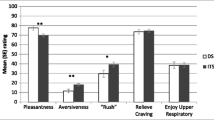Abstract
Objective
The Questionnaire on Smoking Urges is now very widely used as a measure of craving but is considerably longer than alternatives in current use. Longer scales carry a significant cost in studies and clinical practice. This study compared the ten-item Questionnaire on Smoking Urges (QSU-brief) with six shorter measures of craving in terms of sensitivity to abstinence and reliability.
Methods
Sixty smokers were randomly assigned to continue smoking (N = 30) or abstain completely for 24 h (n = 30), by which time the craving would be expected to have increased. Craving was measured at baseline and after 24 h. The craving measures tested were the QSU-brief, the Minnesota Nicotine Withdrawal Scale (MNWS), the Mood and Physical Symptoms Scale (MPSS), the Shiffman Scale (SS), the Wisconsin Smoking Withdrawal Scale and the Cigarette Withdrawal Scale and a simple rating of ‘craving’ (CR).
Results
All measures showed significant increases in scores following smoking abstinence. The two-item MPSS measure was similar to the QSU-brief (eta-squared 0.41 versus 0.45, respectively), and the CR was only slightly lower (eta-squared 0.37). The MNWS showed the least sensitivity (eta-squared 0.22). Stability while still smoking was good with the exception of the SS which showed a significant reduction on retest.
Conclusions
The ten-item QSU-brief is not more sensitive to abstinence or reliable than the two-item MPSS or a single rating of craving.
Similar content being viewed by others
References
Allen SS, Bade T, Hatsukami D, Center B (2008) Craving, withdrawal, and smoking urges on days immediately prior to smoking relapse. Nicotine Tob Res 10(1):35–45
Bagot KS, Heishman SJ, Moolchan ET (2007) Tobacco craving predicts lapse to smoking among adolescent smokers in cessation treatment. Nicotine Tob Res 9(6):647–652
Cox LS, Tiffany ST, Christen AG (2001) Evaluation of the brief questionnaire of smoking urges (QSU-brief) in laboratory and clinical settings. Nicotine Tob Res 3(1):7–16
Etter JF (2005) A self-administered questionnaire to measure cigarette withdrawal symptoms: the Cigarette Withdrawal Scale. Nicotine Tob Res 7(1):47–57
Etter JF, Hughes JR (2006) A comparison of the psychometric properties of three cigarette withdrawal scales. Addiction 101(3):362–372
Fagerstrom K, Furberg H (2008) A comparison of the Fagerstrom Test for Nicotine Dependence and smoking prevalence across countries. Addiction 103(5):841–845
Goddard E (2007) Smoking and drinking among adults, 2006: general household survey. Office of National Statistics, London
Heatherton TF, Kozlowski LT, Frecker RC, Fagerstrom KO (1991) The Fagerstrom Test for Nicotine Dependence: a revision of the Fagerstrom Tolerance Questionnaire. Br J Addict 86(9):1119–1127
Heishman SJ, Singleton EG, Moolchan ET (2003) Tobacco Craving Questionnaire: reliability and validity of a new multifactorial instrument. Nicotine Tob Res 5(5):645–654
Hughes JR, Hatsukami D (1986) Signs and symptoms of tobacco withdrawal. Arch Gen Psychiatry 43(3):289–294
Hughes JR, Hatsukami DK, Pickens RW, Krahn D, Malin S, Luknic A (1984) Effect of nicotine on the tobacco withdrawal syndrome. Psychopharmacology (Berl) 83(1):82–87
Killen JD, Fortmann SP (1997) Craving is associated with smoking relapse: findings from three prospective studies. Exp Clin Psychopharmacol 5(2):137–142
Oppenheim AN (2001) Questionnaire design, interviewing and attitude measurement. Continuum, London
Shiffman S, Khayrallah M, Nowak R (2000) Efficacy of the nicotine patch for relief of craving and withdrawal 7–10 weeks after cessation. Nicotine Tob Res 2(4):371–378
Swan GE, Ward MM, Jack LM (1996) Abstinence effects as predictors of 28-day relapse in smokers. Addict Behav 21(4):481–490
Taylor AH, Ussher MH, Faulkner G (2007) The acute effects of exercise on cigarette cravings, withdrawal symptoms, affect and smoking behaviour: a systematic review. Addiction 102(4):534–543
Tiffany ST, Drobes DJ (1991) The development and initial validation of a questionnaire on smoking urges. Br J Addict 86(11):1467–1476
Welsch SK, Smith SS, Wetter DW, Jorenby DE, Fiore MC, Baker TB (1999) Development and validation of the Wisconsin Smoking Withdrawal Scale. Exp Clin Psychopharmacol 7(4):354–361
West R, Hajek P (1997) What happens to anxiety levels on giving up smoking? Am J Psychiatry 154(11):1589–1592
West R, Hajek P (2004) Evaluation of the mood and physical symptoms scale (MPSS) to assess cigarette withdrawal. Psychopharmacology (Berl) 177:195–199
West RJ, Russell MA (1985) Pre-abstinence smoke intake and smoking motivation as predictors of severity of cigarette withdrawal symptoms. Psychopharmacology (Berl) 87(3):334–336
West R, Schneider N (1987) Craving for cigarettes. Br J Addict 82(4):407–415
West RJ, Jarvis MJ, Russell MA, Carruthers ME, Feyerabend C (1984) Effect of nicotine replacement on the cigarette withdrawal syndrome. Br J Addict 79(2):215–219
West RJ, Hajek P, Belcher M (1989) Severity of withdrawal symptoms as a predictor of outcome of an attempt to quit smoking. Psychol Med 19(4):981–985
West R, Courts S, Beharry S, May S, Hajek P (1999) Acute effect of glucose tablets on desire to smoke. Psychopharmacology (Berl) 147(3):319–321
West R, Ussher M, Evans M, Rashid M (2006) Assessing DSM-IV nicotine withdrawal symptoms: a comparison and evaluation of five different scales. Psychopharmacology (Berl) 184(3–4):619–627
West R, Baker CL, Cappelleri JC, Bushmakin AG (2008) Effect of varenicline and bupropion SR on craving, nicotine withdrawal symptoms, and rewarding effects of smoking during a quit attempt. Psychopharmacology (Berl) 197(3):371–377
Acknowledgements
We are grateful to cancer Research UK for part funding of this study. We also wish to thank Mari Evans and Mamun Rashid for help with data collection.
Author information
Authors and Affiliations
Corresponding author
Appendix: Craving measures and their rating scales
Appendix: Craving measures and their rating scales

Rights and permissions
About this article
Cite this article
West, R., Ussher, M. Is the ten-item Questionnaire of Smoking Urges (QSU-brief) more sensitive to abstinence than shorter craving measures?. Psychopharmacology 208, 427–432 (2010). https://doi.org/10.1007/s00213-009-1742-x
Received:
Accepted:
Published:
Issue Date:
DOI: https://doi.org/10.1007/s00213-009-1742-x



